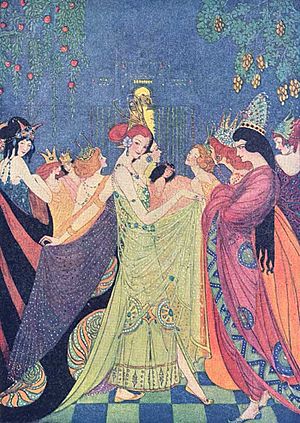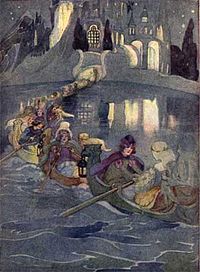The Twelve Dancing Princesses facts for kids
Quick facts for kids The Twelve Dancing Princesses |
|
|---|---|

1920 illustration by Elenore Abbott
|
|
| Folk tale | |
| Name | The Twelve Dancing Princesses |
| Data | |
| Aarne-Thompson grouping | ATU 306 |
| Country | Germany |
| Region | Münster |
| Published in | Kinder- und Hausmärchen |
| Related | Kate Crackernuts |
"The Twelve Dancing Princesses" is a famous fairy tale from Germany. It's also known as "The Worn-Out Dancing Shoes." The story was collected by the famous Brothers Grimm and published in their book Grimm's Fairy Tales in 1812. It's a mystery story about how twelve princesses manage to wear out their dancing shoes every single night, even though their bedroom door is locked!
Contents
The Story of the Dancing Princesses
The King's Problem
In this tale, a king has twelve beautiful princesses. Every night, these princesses sleep in twelve separate beds in the same room. Their father, the king, makes sure their door is locked securely. But each morning, a strange thing happens: their dancing shoes are completely worn out! It looks like they've been dancing all night long. The king is very confused and asks his daughters what's going on, but they won't tell him.
The king then makes a big promise. He says he will give his kingdom and one of his daughters to any man who can figure out the princesses' secret. This person has three days and three nights to solve the mystery. However, if they fail, they will face serious consequences. Many brave princes try, but none succeed.
The Clever Soldier
One day, an old soldier who has returned from war hears about the king's challenge. He decides to try his luck. On his way to the palace, he meets an old woman in a wood. She gives him a special magic cloak that can make him invisible. She also gives him some important advice: "Don't eat or drink anything the princesses offer you in the evening. And pretend to be fast asleep until they leave."
The soldier arrives at the palace and is welcomed. That evening, the eldest princess comes to his room and offers him a cup of wine. Remembering the old woman's warning, the soldier secretly pours the wine away. Then, he starts to snore loudly, pretending to be deeply asleep.
Following the Princesses
Once the princesses are sure the soldier is asleep, they get dressed in their beautiful dancing gowns. They then open a secret trap door in the floor of their room and disappear! The soldier quickly puts on his magic cloak and follows them. He accidentally steps on the gown of the youngest princess, who cries out. But her older sister tells her it's nothing.
The secret passage leads them to three amazing groves of trees. The first grove has leaves made of shiny silver. The second has leaves of sparkling gold. And the third grove has leaves of glittering diamonds! The soldier wants proof of where he's been, so he breaks off a small twig from each type of tree.
They keep walking until they reach a large, clear lake. Suddenly, twelve boats appear, each with a handsome prince waiting. Each princess gets into a boat, and the soldier quietly slips into the boat with the youngest princess. She complains that her prince isn't rowing fast enough, not knowing the soldier is there! They cross the lake to a grand castle. Inside, the princesses dance all night long.
The Secret Revealed
The twelve princesses dance until their shoes are completely worn out. Then, they have to leave. This same adventure happens on the second and third nights. On the third night, the soldier also takes a golden cup from the castle as another piece of evidence.
When it's time for the soldier to tell the king the secret, he shows the king the three branches and the golden cup. He tells the king everything he saw. The princesses know they can't deny the truth anymore, so they confess. The soldier, who is not a very young man, chooses the eldest princess to be his wife. He is then made the king's heir, meaning he will become king one day. The twelve princes who danced with the princesses are put under a curse for as many nights as they danced.
Where the Story Comes From
The Brothers Grimm heard this tale from their friends, the Haxthausens, who lived in Münster, Germany. Other versions of the story were also known in different parts of Germany. For example, in one version from Hesse, only one princess was wearing out shoes, and a young shoemaker's helper discovered she was dancing with eleven other princesses. In another version from Paderborn, there were three princesses.
Some older versions of the story had a very harsh rule for those who failed to solve the mystery. However, later storytellers, like those in Victorian times, didn't like this part. So, in many versions, the princes who failed simply vanished or were enchanted and trapped in an underground world, instead of facing a more serious consequence.
The idea of a garden with trees that have silver, gold, and diamond leaves is also found in very old stories, like the Sumerian epic of Gilgamesh.
Different Versions of the Story
This fairy tale is quite old, likely from the 1600s or later. Many different versions of "The Twelve Dancing Princesses" exist around the world!
- Europe: You can find similar stories in Scotland (like Katie Crackernuts), France, Portugal, Denmark, Iceland, Czech Republic, Slovakia, Hungary, Romania, Russia, and Armenia.
- Africa: A version called The Shoes That Were Danced To Pieces is known in Cape Verde.
- Middle East: Stories like The Magic Turban, the Magic Whip, and the Magic Carpet from Turkey and The Golden City from Arabic traditions are similar.
- Asia: In India, there's Dorani and The Invisible Woman. In Bengal, there's The Kotwal’s Daughter.
In some versions, there might be a different number of princesses. Sometimes, a princess might even dance with a magical or supernatural character, like the Devil.
Adaptations and Other Stories
This popular fairy tale has been retold and adapted in many ways, including books, movies, and TV shows!
- The Barbie in the 12 Dancing Princesses movie is a well-known adaptation. In this version, Barbie plays the seventh sister, Genevieve. The story changes quite a bit, with the princesses trying to escape an evil governess.
- The children's TV show Super Why! also had an episode called "The Twelve Dancing Princesses." In this version, the princesses are planning a surprise party for their father!
- Many authors have written their own versions of the story, like Jeanette Winterson in Sexing the Cherry and Robin McKinley in The Door in the Hedge.
- Patricia A. McKillip wrote an adaptation where the princes the princesses were dancing with were actually dead and planning to take the princesses away forever.
- The novel Wildwood Dancing by Juliet Marillier retells the story in Transylvania, mixing it with local folk tales.
- Jessica Day George's novel Princess of the Midnight Ball adds a twist: the princesses are cursed to dance every night for an evil sorcerer.
- The anime series Grimm's Fairy Tale Classics has only three princesses. In this version, demons are involved, and the soldier has to rescue the princesses from their spell.
- The Ever After High series, which includes web series, films, and books, features a character named Justine Dancer, who is the daughter of the youngest dancing princess.
- The Hungarian television series Magyar népmesék ("Hungarian Folk Tales") adapted a Hungarian version of the tale. In this story, the princesses ride magical brooms and dance with devils on a floor made of razors!


